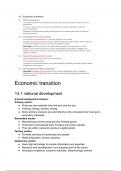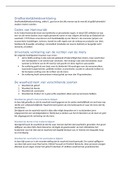Economic transition
14.1 national development
4 broad employment sectors:
Primary sector:
● Produces raw materials from the land and the sea
● Farming, fishing, forestry, mining
● Some primary products are sold directly to the consumers but most go to
secondary industries
Secondary sector:
● Manufactures primary products into finished goods
● Production of processed food, furniture and motor vehicles
● They are either consumer goods or capital goods
Tertiary sector:
● Provides services to businesses and people
● Retail employees, drivers, teachers
Quaternary sector:
● Uses high technology to provide information and expertise
● Research and development is an important part of this sector
● Aerospace engineers, research scientists, biotechnology workers
,The product chain
● The product chain considers the full sequence of activities needed to turn raw
materials into finished products
How employment structures changed over time
● In post-industrial societies, most people work in the tertiary sector (like USA
and UK)
● In 1900, 40% of all employees worked in the primary sector in the USA,
however, the mechanisation of farming, mining and forestry drastically
reduced the labour in these industries
● When all these jobs disappeared, people moved to urban areas to find jobs in
the secondary and tertiary sectors as they were expanding
● Now, 10.5% of employment in the USA is now in the primary sector
● Human labour has been replaced in manufacturing too as robots and
advanced technologies handle assembly-line jobs
● Many manufacturing jobs once done by Americans are now done in NICs
● In 1950, the same number of Americans worked in the secondary and tertiary
sectors, by 1980 ⅔ were working in services
● In the tertiary sector, many businesses reduced the number of people
required (banking)
● But elsewhere, service employment is rising such as health, education and
tourism
How employment structures vary between LICs, MICs and
HICs
LICs
● LICs are heavily dependent on the primary sector for employment
● Most of these people work in agriculture and many are a subsistence farmer
● In densely populated areas with limited land, there won’t be work for everyone
full a full working week
● The work available is often shared and people are underemployed
● In some regions, mining, quarrying, forestry or fishing may dominate the
economy
● Miners in LICs get better pay than other primary sector jobs, but the working
conditions are harsh
● The number of jobs in the secondary, tertiary and quaternary sectors is small
● Public-sector jobs like nurses and teachers are paid by the government,
however, the funds are usually low and so are their wages
● Many of the world’s poorest countries are primary-product dependent,
meaning that they rely on a small number of primary products for most of their
export earnings
, ● The rapidly changing business environment makes these countries
vulnerable, if the exported goods fall in value the country will have less money
to pay for the imports they need and other important aspects that can improve
the quality of life
○ Primary products compromised 79% of exports of the Pacific Islands in
2010
○ 80% of Chad’s total employment is in agriculture
○ Oil accounts for 97% of the value of Angola’s exports
MICs
● In MICs, employment in manufacturing has increased rapidly in recent
decades
● MICs reached that stage of development where they attract FDI from TNCs in
the manufacturing and service sectors
● For most MICs, the manufacturing industry had been the bedrock for exports
and development
● The business environment in MICs is such that they develop their own
domestic companies
● Both of these processes create employment in manufacturing and services
● The increasing wealth of MICs allows for greater investment in agricultural
● This includes mechanisation, which results in falling demand for labour on the
land
● As employment in the secondary and tertiary sectors rises, employment in the
primary sector falls
● Eventually, MICs might become so advanced that they start to develop their
own quarterly sector
○ South Korea
○ Singapore
○ Taiwan
HICs
● Called post-industrial societies because fewer people are employed in
manufacturing
● Most people work in the tertiary sector with an increasing number in the
quaternary
● Jobs in the manufacturing industry fell due to:
○ Many manufacturing industries moved to LICs and MICs to take
advantage of the lower costs like cheaper labour
○ Investment in robotics and other advanced technology had replaced
much human labour in many manufacturing industries in HICs
, Outsourcing
● Companies starting outsourcing employees to reduce costs
● Work can be outsourced to companies in the same country or abroad, where
labour and other costs are much cheaper
● For example, many British and American companies outsourced their call
centres to India
● The advancements in technology and communication are the reason
outsourcing was possible to develop into a major global industry
● As higher levels of ICT have spread down the global economic hierarchy from
the core to the periphery, more and more countries have been competing for
the business
The future employment structure
● Employment is the most important factor in most people’s lives as they
depend on their income which influences the aspects of an individual’s quality
of life
● With further advances in technology, more people will be able to work from
home, this is called teleworking
● It seems likely that international commuting and employment migration will
increase as economic and psychological barriers to movement recede
Global Inequalities in Social and economic well-being
Development and its traditional income measures
● Development or improvements in quality of life includes wealth and other
aspects too
● For some people, it means a different concept like good health or freedom of
speech
● Development occurs when there are improvements in individual factors
making up the quality of life
Economic Physical Social Psychological
income diet/nutrition family Happiness
Job security Water supply friends Security
Standard of living climate Education freedom
Housing, mobility etc Environmental hazards Health
Factors compromising the quality of life





